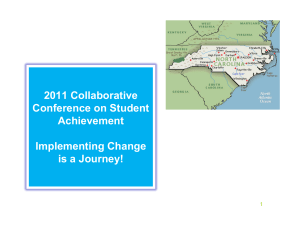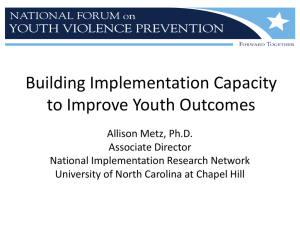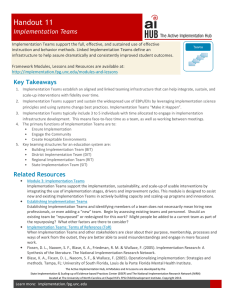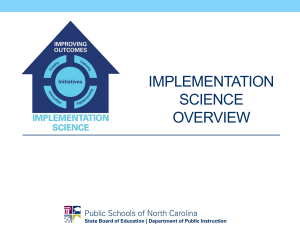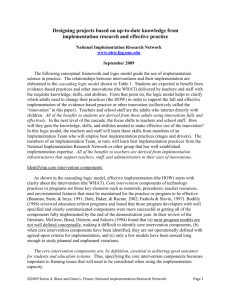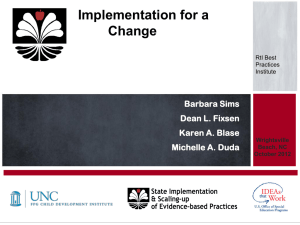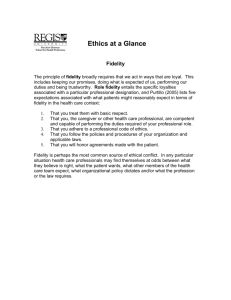Running Head: AIF FOR SUCCESSFUL SERVICE DELIVERY
advertisement
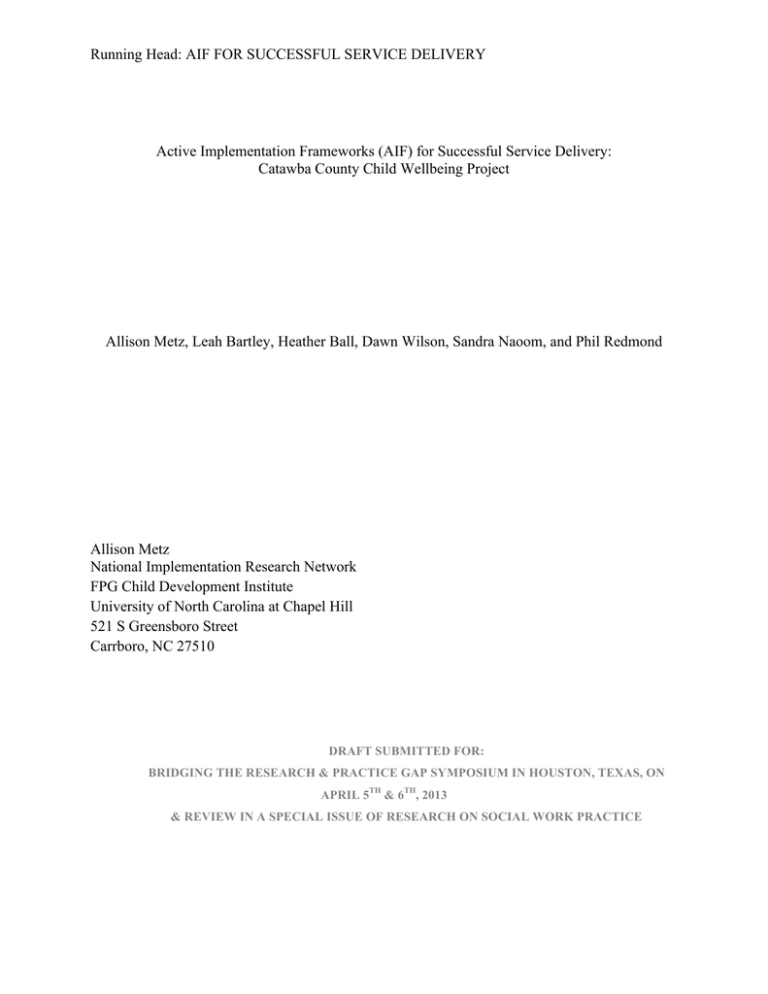
Running Head: AIF FOR SUCCESSFUL SERVICE DELIVERY Active Implementation Frameworks (AIF) for Successful Service Delivery: Catawba County Child Wellbeing Project Allison Metz, Leah Bartley, Heather Ball, Dawn Wilson, Sandra Naoom, and Phil Redmond Allison Metz National Implementation Research Network FPG Child Development Institute University of North Carolina at Chapel Hill 521 S Greensboro Street Carrboro, NC 27510 DRAFT SUBMITTED FOR: BRIDGING THE RESEARCH & PRACTICE GAP SYMPOSIUM IN HOUSTON, TEXAS, ON APRIL 5TH & 6TH, 2013 & REVIEW IN A SPECIAL ISSUE OF RESEARCH ON SOCIAL WORK PRACTICE AIF FOR SUCCESSFUL SERVICE DELIVERY 2 Abstract Traditional approaches to disseminating evidence-based programs and innovations for children and families, which rely on practitioners and policy-makers to make sense of research on their own, have been found insufficient. There is growing interest in strategies that “make it happen” by actively building the capacity of service providers to implement innovations with high fidelity and good effect. This paper provides an overview of the Active Implementation Frameworks (AIF), a science-based implementation framework, and describes a case study in child welfare where the AIF was used to facilitate the implementation of evidence-based and evidence-informed practices to improve the wellbeing of children exiting out of home placement to permanency. In this paper we provide descriptive data that suggest AIF is a promising framework for promoting high-fidelity implementation of both evidence-based models and innovations through the development of active implementation teams. Part I: Active Implementation Frameworks AIF FOR SUCCESSFUL SERVICE DELIVERY 3 Traditional approaches to disseminating evidence-based programs and innovations for children and families, which rely on administrators, practitioners, and policy-makers to make sense of research on their own, have been found insufficient (Balas & Boren, 2000; Clancy, 2006; Mihalic et al., 2004). Recent reports (Institute of Medicine, 2000, 2001,and 2007) have highlighted the gap between researchers’ knowledge of effective interventions and the services actually received by vulnerable populations who could benefit from these interventions. There is growing interest in strategies that “make it happen” (Fixsen, Blase, Duda, Naoom, & Van Dyke, 2010; Greenhalgh, Robert, MacFarlane, Bate, & Kyriakidou, 2004; Hall & Hord, 2011) by actively building the capacity of service providers to implement innovations with high fidelity and good effect. In 2005, the National Implementation Research Network released a monograph (Fixsen, Naoom, Blase, Friedman, & Wallace, 2005) that synthesized trans-disciplinary research on implementation evaluation, resulting in the Active Implementation Frameworks (AIF). The review of the literature has continued since 2005 and has resulted in modifications and additions to the frameworks and best practices (Blase, Van Dyke, & Fixsen, in press; Fixsen, Blase, Metz, & Van Dyke, 2013; Fixsen et al., 2010). The AIF include: 1. Usable Intervention Criteria –Fully operationalized programs and practices necessary to build implementation supports and measure fidelity. 2. Stages of Implementation—Stage-appropriate implementation activities necessary for successful service and systems change. 3. Implementation Drivers- Core components of the infrastructure needed to support practice, organizational, and systems change. AIF FOR SUCCESSFUL SERVICE DELIVERY 4 4. Improvement Cycles—Use Processes to use data to drive decision-making and institutionalize policy-practice feedback loops. 5. Implementation Teams—Accountable structures for moving innovations through the stages of implementation. Usable Intervention Criteria A prerequisite for implementation is to ensure that core intervention components are identified and fully operationalized. However, there are few adequately defined programs, creating a major challenge for service providers who attempt to use evidence-based or evidenceinformed innovations in their agency (Dane & Schneider, 1998; Durlak & Dupree, 2008; Michie et al., 2011;Stirman et al., 2012; The Improved Clinical Effectiveness through Behavioural Research Group, 2006). Criteria necessary for successful implementation include: a clear description of the program or practice’s principles and theory; a clear description of the essential functions that define the program; practice profiles (or other mechanisms) that operationally define the essential functions (Metz, Bartley, Base and Fixsen, 2011; Hall and Hord, 2011); and practical assessments of the performance of practitioners who are using the program(see Fixsen, Blase, Metz & Van Dyke, 2013 for a complete description). Stages of Implementation There is substantial agreement that planned change happens in discernible stages (Aarons, Hurlburt, & Horowitz, 2011; Meyers, Durlak & Wandersman, 2012; Rogers, 2003). AIF specifies four functional stages of implementation (Table 1). Each stage has a unique set of activities and structures that support moving to the next stage of implementation effectively. Sustainability is embedded within each of the four stages rather than considered a discrete, final stage (see Metz & Bartley 2012 for a more extensive description of each stage in AIF). Each AIF FOR SUCCESSFUL SERVICE DELIVERY 5 stage of implementation does not cleanly and crisply end as another begins. Often they overlap with activities related to one stage still occurring or reoccurring as activities related to the next stage begin. Implementing a well-constructed, well-defined, well-researched program can take 2 to 4 years (Bierman et al., 2002; Fixsen, Blase, Timbers, & Wolf, 2001; Panzano& Roth, 2006; Prochaska&DiClemente, 1982; Solberg, Hroscikoski, Sperl-Hillen, O’Conner, & Crabtree, 2004). Table 1 Stages of Implementation Exploration Installation – Assess needs – Examine fit and feasibility – Involve Stakeholders – Operationalize model – Make Decisions – New services not yet delivered – Develop implementation supports – Make necessary structural and instrument changes Initial Implementation – Service delivery initiated – Data use to drive decision-making and continuous improvement – Rapid cycle problem solving Full Implementation – Skillful implementation – System and organizational changes institutionalized – Child and family outcomes measureable Note: (2-4 years to reach Full Implementation) Implementation Drivers The implementation drivers are the core components or building blocks of the infrastructure needed to support practice, organizational, and systems change. The implementation drivers emerged on the basis of the commonalities among successfully implemented programs and practices (Fixsen et al., 2005; Fixsen, Blase, Duda, Naoom, & Wallace, 2009), and the structural components and activities that make up each implementation driver contribute to the successful and sustainable implementation of programs, practices, and innovations (Figure 1). There are three types of implementation drivers and when used collectively, they ensure high-fidelity and sustainable program implementation: competency drivers, organization drivers, and leadership drivers. AIF FOR SUCCESSFUL SERVICE DELIVERY 6 Figure 1. Implementation Drivers Competency drivers are mechanisms to develop, improve, and sustain practitioners’ and supervisors’ ability to implement a program or innovation to benefit children and families. Organization drivers intentionally develop the organizational supports and systems interventions needed to create a hospitable environment for new programs and innovations by ensuring that the competency drivers are accessible and effective and that data are used for continuous improvement. Leadership drivers ensure that leaders use appropriate strategies to address different types of challenges and that diversified leadership is built throughout an organization at every level of the system. The drivers serve both integrative and compensatory functions in such a way that weaknesses in one driver can be compensated by strengths in other drivers. Implementation Teams Active implementation requires building the local capacity of service systems to use evidence with high-fidelity and good effect. This can be done through the development and support of implementation teams, which provide an internal structure to move selected programs and practices through the stages of implementation in organizations and systems. Implementation teams have been found to reduce time to implementation (Fixsen, Blase, Timbers, and Wolf, AIF FOR SUCCESSFUL SERVICE DELIVERY 7 2001; Balas & Boren, 2000) and effectively perform critical functions in the implementation and scale-up process (Chamberlain et al., 2011; Higgins, Weiner and Young, 2012; Saladana & Chamberlain, 2012). An advantage of relying on implementation teams is that the team collectively has the knowledge, skills, abilities, and time to succeed. Table 2 highlights core competencies of successful implementation teams. Table 2. Core Competencies of Successful Implementation Teams Develop Team Know and Apply Know and Apply Know and Apply Structure the Intervention Implementation Improvement Cycles Represent the Assess “fit” of Develop Institutionalize system intervention with infrastructure feedback loops local context Provide accountable structure for moving change forward Demonstrate fluency in strategy Conduct stageappropriate work Use data for decision making, problem solving and action planning Develop MOU, Communication Protocols Operationalize intervention as needed Use adaptive leadership skills Functionally engaged leaders Know and Apply Systems Change Demonstrate knowledge of system components Use skills for system building and increased cross-section collaboration Establishing Cross-Sector Leadership through Implementation Teams There is a strong case to be made that individual leadership matters for effective implementation in organizations and systems (Aarons & Sommerfeld, 2012; Easterling, 2013; Easterling & Millesen, 2012). In order for an agency to solve its most pressing problems, diversified, cross-sectional leadership needs to be grown and maintained. Implementation teams take on the role of “adaptive problem solving units” focused on quality, integration, sustainability of drivers; data-based decision-making; problem-solving and analytical engagement; purposeful adaptation and planned supports; alignment and sustainability. AIF FOR SUCCESSFUL SERVICE DELIVERY 8 Therefore, building capacity requires more than just forming implementation teams. There needs to be new ways of organizing to address complex problems; talking about issues; making decisions; and relating to one another. In order to achieve this, cross-sector leadership competencies need to be developed and nurtured for implementation team members. A leadership framework developed by the Kansas Leadership Center (O’Malley, 2009) identifies core leadership competencies for community leaders. These competencies are also essential for successful implementation team members. Table 3 Leadership Competencies for Implementation Team Diagnose Situation Distinguish technical vs. adaptive issues Manage Self Comfort with uncertainty and conflict Energize Others Engaged all and nontraditional voices Intervene Skillfully Make conscious choices Understand competing, yet legitimate perspectives Understand person strengths and challenges and how other perceived you Work across sectors Give the work back Inspire collective process Raise the heat and hold the pressure Test multiple interpretations and points of view Experiment beyond comfort zone Create a trustworthy process Speak from the heart Identify who needs do the work Choose among competing values Act experimentally Start where they are and speak to loss Note: Adapted from the Kansas Leadership Center (O’Malley, 2009) Improvement Cycles Many initiatives fail due to lack of attention to what is actually supported and practiced and the results from those actions (National Association of Public Child Welfare Administrators, 2005; U.S. Department of Health and Human Services, 1999 and 2001; U.S. Department of Education, 2011). Using data to change on purpose is a critical function of implementation teams who are faced with range of decisions related to potential adaptations AIF FOR SUCCESSFUL SERVICE DELIVERY 9 to program models, practice and policy level barriers to implementation, and the use of data to improve service delivery. Part II: Application of AIF: A Case Study of the Catawba County Child Wellbeing Project In 2007 the Catawba County Department of Social Services in North Carolina, in partnership with The Duke Endowment, embarked on an initiative to expand services for children and families engaged in the child welfare system beyond the mandated service continuum with the goal of improving foster youth’s transition to adulthood. The Child Wellbeing Project developed a continuum of post-care services for children and their families in permanent placements that were either evidence-based (services have been evaluated and have evidence of effectiveness) or evidence-informed (services were developed using information from research and practice). Six services were selected, developed and implemented: Educational Advocate, Success Coach (home visiting and enhanced case management service), Material Supports, Strengthening Families Program, Parent Child Interaction Therapy, and Adoption Support Groups. The National Implementation Research Network (NIRN) applied the AIF (Metz & Bartley, 2012, Fixsen et al., 2009, Fixsen et al., 2005) to promote successful program operations for the Child Wellbeing Project. Two key aspects of the overall approach are highlighted: implementation teams and leadership, and implementation drivers and continuous improvement. Descriptive data are provided to demonstrate the promising nature of the AIF for developing local capacity and leadership, improving fidelity and promoting positive outcomes. AIF FOR SUCCESSFUL SERVICE DELIVERY 10 Developing the Implementation Team Structure Implementation team structures are determined by the size and scope of the initiative. The Child Wellbeing Project developed multiple implementation teams at each level of the system (leadership, management, and practice) due to the breadth of the post care services and the need for buy-in and expertise agency-wide (see Figure 2). Each team developed an internal memorandum of understanding that described how it functions, communicates, makes decisions, and moves forward with its mission and objectives. The Cross Services Team served as the “hub” of the wheel ensuring service alignment, continuity, and coordination across the different post-care services that were selected for implementation. The Implementation Services Teams provided innovation expertise that informed the decisions of the Cross Services Team. Finally, a Design Team provided overall leadership and was responsible for final decision-making with funding implications. The composition of teams changed over time, but an accountable structure remained in place. Figure 2: Child Wellbeing Project Implementation Teams Design Team Success Coach Parent Education Material Supports Mental Health Implementation Services Teams Adoption Services Cross Services Team Educational Services Building Team Competencies NIRN built the capacity of the teams to employ the AIF and use evidence-based implementation methods related to usable intervention criteria, stages, drivers, and improvement AIF FOR SUCCESSFUL SERVICE DELIVERY 11 cycles. Implementation teams were provided with intensive implementation support to promote the five core competencies (Table 2). As a result of building these core competencies and developing transformational and adaptive leadership skills (Table 3), teams successfully promoted high-fidelity implementation and addressed organization and systems barriers. Table4 outlines the linkages between core competencies and results of effective implementation teams in Catawba County. Table 4 Results of Successful Implementation Teams Core Competencies Team Results Achieved by Teams Develop team structure Team accessed decision-makers, made decision and affected systems change Know and apply the intervention Team operationalized and/or adapted models and promoted implementation of core components Know and apply implementation Team guided stage-based implementation and built organizational and system infrastructure Know and apply improvement cycles Team used data for problem solving and action planning and institutionalized feedback loops Know and apply systems Team improved access, reach or scale, made connections and change influenced decision-making Installing, Assesing and Improving the Implementation Infrastructure: Stage-Based Drivers Assessments Implementation teams used data on a regular basis to assess and improve the interventions and the implementation infrastructure. Annually, teams assessed how well the implementation drivers were functioning to support each of the post-care service interventions using the Assessment of Initial Implementation (NIRN, 2012) facilitated by NIRN. The assessment measured the extent to which best practices associated with each of the AIF FOR SUCCESSFUL SERVICE DELIVERY 12 implementation drivers was in place, partially in place, or not in place. It should be noted that NIRN coached implementation teams to eventually facilitate these assessments independently. The “best practices” for each implementation driver are extracted from meta-analyses, primary studies, and NIRN’s interactions with program developers (Blase, Fixsen, Naoom, & Wallace, 2005; Fixsen, Naoom, Blase, Friedman, & Wallace, 2005; Naoom, Blase, Fixsen, Van Dyke, & Bailey, 2010; Rhim, Kowal, Hassel, & Hassel, 2007).Acceptable psychometric properties for the Assessment of Initial Implementation were established in a previous study, which calculated the internal consistency of the individual scales for each implementation driver (Ogden et al., 2012). Composite scores were created for each Driver by assigning a 0 for “not in place,” 1 for “partially in place,” and 2 for “in place.” These data were used by the teams for action planning, strengthening driver functioning, and improving the compensatory and integrative aspects of the drivers. Success Coach Model Table 5 summarizes the implementation driver scores for initial implementation of the Success Coach Model at T1 (3 months), T2 (12 months), and T3 (24 months). Fidelity scores were also calculated by a third-party evaluator and are included to describe linkages between changes in the implementation infrastructure and changes in overall fidelity. It should be noted that different metrics were used to assess fidelity at T1 than at T2 and T3. At T1, fidelity criteria were not firmly established. An early indicator of fidelity was whether family assessment data matched goals included in the change-focused case plan. This goodness of fit between assessments and goal planning was used to assess fidelity in T1. The T2 and T3 fidelity scores were derived from matching case notes with the interventions Success Coaches reported using in the program database. There was a single fidelity assessment completed for T2 and T3 that AIF FOR SUCCESSFUL SERVICE DELIVERY 13 included all cases during both of those time periods. Therefore, the 83% fidelity achieved during that time was a single assessment. Sample sizes (families served) were low during initial implementation but increased over the first 18 months (n=14 at T1; n=39 at T2 and T3). Table 5.Implementation Driver Scores and Fidelity for Success Coach Model Component Selection Training Coaching Perf. Assessment DSDS Fac. Administration Systems Intervention Average Composite Score Fidelity (% of cases) T1 1.44 1.33 1.27 0.78 0.18 1.38 1.29 1.1 T2 2.00 1.5 1.73 1.34 1.36 2.00 1.86 1.68 T3 1.89 1.10 1.83 2.0 2.0 2.0 2.0 1.83 18% 83% 83% The Implementation team used data from T1 to intentionally and actively strengthen the implementation infrastructure in order to improve overall fidelity. The Implementation team focused on improving coaching, administrative support, and the use of data to drive decisionmaking. They also diagnosed challenges, engaged stakeholders, and inspired change at the agency. While these are descriptive data with low sample sizes, the data offer support for the promise of the AIF in supporting effective implementation. As implementation drivers were monitored, assessed, and actively strengthened by implementation teams, fidelity scores improved. The low samples sizes and lack of design rigor impede our ability to make direct conclusions, but emerging data also demonstrated that the Success Coach model stabilized families and prevented reentry into out of home placement. Strengthening Families Program and Parent Child Interaction Therapy Implementation teams also used the Drivers framework to ensure that infrastructures were developed and maintained for evidence-based programs that involved national purveyors AIF FOR SUCCESSFUL SERVICE DELIVERY 14 who helped Catawba County to install the implementation drivers. The Strengthening Families Program(SFP) and Parent Child Interaction Therapy (PCIT) provide two unique examples of how implementation teams can complement and in some cases improve the implementation supports provided by national purveyors. An intitial review of the infrastructure indicated that the national training office for SFP only installed the training driver. It was up to the implementing site, in this case Catawba County Social Services, to install the other drivers effectively and to measure fidelity to the model. Teams used the AIF to “fill in the gaps” and build a solid infrastructure for SFP during the installation stage. This effort yielded a strong implementation infrastructure and high fidelity scores during the first and second delivery of the intervention during initial implementation (Table 6). Seven parents with eight children completed SFP across the two sessions. Fidelity scores are reported for the percentage sessions where fidelity was achieved. A range is reported to include individual scores for parent, children, and family sessions. A National Learning Collborative (Duke EPIC at Duke University) served as the purveyor for PCIT and installed almost all of the implementation drivers for Catawba County. However, the learning collaborative model focused on building the capacity of Catawba County to eventually take over all driver-related functions. The team prepared during the first year (T1 in Table) to take over these functions and demonstrated a strong infrastructure after the learning collaborative ended and maintained high fidelity scoreswithout puveyor involvement (T2 in Table). Nine active cases were included in the fidelity analysis across more than 30 sessions per case. Data from all of the interventions indicate that building the competencies of implementation teams to strengthen the implementation driversis associated with improved AIF FOR SUCCESSFUL SERVICE DELIVERY 15 fidelity for evidence-based models and innovations. Data also indicate that an overall composite score of 1.5 may serve as “threshold” for the infrastructure needed to support high fidelity implemenation of any innovation. Table 6. Implementation Driver and Fidelity Scores for SFP and PCIT Component Selection Training Coaching Perf. Assessment DSDS Fac. Administration Systems Intervention Average Composite Score Fidelity (% of cases) SFP T1 1.56 1.00 1.82 1.89 1.90 1.88 1.86 SFP T2 1.67 1.20 1.50 2.00 2.00 2.00 2.00 PCIT T1 0.33 2.00 1.64 1.33 1.91 1.75 PCIT T2 0.78 1.80 1.42 2.00 2.00 2.00 2.00 1.70 1.77 1.63 1.51 1.71 93-100% 92-98% 85% 82% Discussion This case study provides promising data for the use of the Active Implementation Frameworks to promote high fidelity implementation of evidence-based models and innovations. Investing in the development of active implementation teams and cross-sector leaders was a key aspect of the early successes demonstrated in Catawba County. Implementation teams engaged in the development and installation of implementation drivers to provide the infrastructure for change. Assessments of the implementation drivers provided critical information for action planning to strengthen this infrastructure and improve fidelity over time. Purposeful, rigorous designs are needed to test these findings more thoroughly. AIF FOR SUCCESSFUL SERVICE DELIVERY 16 References Aarons, G.A., Hurlburt, M., & Horwitz, S.M. (2011). Advancing a conceptual model of evidence-based practice implementation inpublic service section. Administration and Policy in Mental Health and Mental health Services Research, 38, 4-23. Aaron, G. & Sommerfield, D. 2009. Leadership, Innovation climate, and attitudes toward evidence-based practice during a statewide implementation. Journal of the American Academy of Child and Adolescent Psychiatry. 51(4), 423-431. Balas, E. A., & Boren, S.A. (2000). Managing clinical knowledge for health care improvement. Yearbook of Medical Informatics 2000: Patient-Centered Systems. J. Bemmel and A. T. McCray. Stuttgart, Germany, Schattauer Verlagsgesellschaft: 65-70. Blase, K., Van Dyke, M., & Fixsen, D. (in press). Implementation science: Key concepts, themes and evidence for practitioners in educational psychology. In B. Kelly & D. Perkins (Eds.), Handbook of implementation science for psychology in education: How to promote evidence based practice. London: Cambridge University Press. Blase, K.A. Fixsen, D.L., Naoom, S.F., & Wallace, F. (2005. Operationalizing implementation strategies and methods. Tampa, FL: University of South Florida, Louis de la Parte Florida Mental Health Institute. Bierman, K. L., Coie, J. D., Dodge, K. A., Greenberg, M. T., Lochman, J. E., McMahon, R. J., et al. (2002). The Implementation of the Fast Track Program: An example of a large-scale prevention science efficacy trial. Journal of Abnormal Child Psychology, 30, 1–17. AIF FOR SUCCESSFUL SERVICE DELIVERY 17 Chamberlain, P., Roberts, R., Jones, H., Marsenich, L., Sosna, T. & Price J.M. (2011). Three collaborative models for scaling up evidence-based practices. Administration, Policy and Mental Health, 39, 278-290. Clancy, C. (2006). The $.1.6 trillion questions: If we’re spending so much on healthcare, why so little improvement in quality? Medscape General Medicine, 8(2), 58. Dane, A.V. & Schneider, B.H. (1998). Program integrity in primary and early secondary prevention: Are implementation effects out of control? Clinical Pschology Review, 18 (1), 23-45. Deming, W. E. (1986). Out of the crisis. Cambridge, MA: MIT Press. Durlak, J.A., & DuPre, E.P. (2008). Implementation matters: A review of research on the influence of implementation on program outcomes and the factors affecting implementation. American Journal of Community Psychology, 41, 327-350. Easterling, D. (2013). Scaling Up Civic Leadership: Combining Individual Level Change and Culture Change. National Civic Review, 101 (2), 51-64. Easterling, D. & Millesen, J. L. (2012). Diversifying civic leadership: What it takes to move from “New Faces” to adaptive problem solving. National Civic Review, 101 (2), 20-26. Fixsen, D.L., Blase, K., Metz, A. & Van Dyke, M. (2013). Statewide implementation of evidence-based programs. Exceptional Children (Special Issue), 79(2), 213-230. Fixsen, D., Blase, K., Duda, M., Naoom, S., & Van Dyke, M. (2010). Implementation of evidence-based treatments for children and adolescents: Research findings and their implications for the future. In J. Weisz & A. Kazdin (Eds.), Implementation and AIF FOR SUCCESSFUL SERVICE DELIVERY 18 dissemination: Extending treatments to new populations and new settings (2nd ed., pp. 435-450). New York: Guilford Press. Fixsen, D. L., Blase, K., Duda, M., Naoom, S., & Wallace, F. (2009) Core implementation components, Research on Social Work Practice, 19, 531–540. Fixsen, D. L., Naoom, S. F., Blase, K. A., Friedman, R. M., & Wallace, F. (2005). Implementation research: A synthesis of the literature. Tampa, FL: University of South Florida, Louis de la Parte Florida Mental Health Institute, National Implementation Research Network. (FMHI Publication No. 231). Fixsen, D. L., Blase, K. A., Timbers, G. D., & Wolf, M. M. (2001). In search of program implementation: 792 replications of the Teaching-Family Model. In G. A. Bernfeld, D. P. Farrington * A. W. Leschield (Eds.), Offender rehabilitation in practice: Implementation and evaluating effective programs (pp. 149–166). London: Wiley. Greenhalgh, T., Robert, G., MacFarlane, F., Bate, P., & Kyriakidou, O. (2004). Diffusion of innovations in service organizations: Systematic review and recommendations. The Milbank Quarterly, 82(4), 581–629. Hall, G. E., & Hord, S. M. (2011). Implementing change: Patterns, principles and potholes (3rd ed.). Boston: Allyn and Bacon. Higgins, M.C., Weiner, J. &Young, L. (2012). Implementation teams: A new lever for organizational change. Journal of Organizational Behavior, published online in Wiley Online Library (wileyonlinelibrary.com) DOI: 10.1022/job.1773 AIF FOR SUCCESSFUL SERVICE DELIVERY 19 Institute of Medicine Committee on Quality of Health Care in America (2000). To err is human: Building a safer health system. In I. Kohn, J. Corrigan, & M. Donaldson (Eds.): Washington, DC: National Academies Press. Institute of Medicine Committee on Quality of Health Care in America (2001). Crossing the quality chasm: A new health system for the 21st century. Washington, DC: National Academies Press. Institute of Medicine (2007). Emergency medical services: At the crossroads. Washington, DC: National Academies Press. Mihalic, S., Fagan, A., Irwin, K., Ballard, D., & Elliott, D. (2004) Blueprints for Violence Prevention. Washington, D.C.: U.S. Department of Justice, Office of Justice Programs, Office of Juvenile Justice and Delinquency Prevention. Metz, A.,&Bartley,L. (2012). Active Implementation Frameworks for program success: How to use implementation science to improve outcomes for children. Zero to Three Journal, 32(4), 11-18. Metz, A., Bartley, L., Blase, K. & Fixsen, D. (2011). A guide for creating practice profiles. Chapel Hill, NC: National Implementation Research Network, FPG, Child Development Institute, UNC. Michie, S., Abraham, C., Eccles, M.P., Francis, J.J., Hardeman, W. & Johnson, M. (2011). Strengthening evaluation and implementation by specifying components of behaviour change interventions: a study protocol. Implementation Science, 6(10). AIF FOR SUCCESSFUL SERVICE DELIVERY 20 Meyers, D.C., Durlak, J.A. & Wandersman, A. (2012). The quality implementation framework: A synthesis of critical steps in the implementation process. American Journal of Community Psychology, 50 (3-4), 462-480. National Association of Public Child Welfare Administrators. (2005). Guide for Child Welfare Administrators on Evidence Based Practice. Washington, DC: American Public Human Services Association. National Implementation Research Network (2012). Assessment of Initial Implementation. Chapel Hill, NC: National Implementation Research Network, FPG, Child Development Institute, UNC. Naoom, S.F., Blase, K., Fixsen, D.L., Van Dyke, M., & Bailiey, F.W. (2012). Implementing evidence-based programs in the real world: Lessons learned from model program developers and purveyors. Chapel Hill, NC: National Implementation Research Network, FPG, Child Development Institute, UNC. Nielsen, J. (1994). Usability laboratories. Behaviour and Information Technology, 13 (1-2), 3-8. Ogden, T. Bjornebekk, G., Kjobli, J. Patras, J., Christiansen, T., Taraldsen, K., et al. (2012). Measurement of implementation components ten years after a nationwide introduction of empirically supported programs – a pilot study. Implementation Science, 7(49) published online: http://www.implementationscience.com/content/7/1/49. O’Malley, E. (2009). The competencies of for civic leadership: An introduction to the core curricular undermining of the KLC. The Journal Kansas Leadership Center,1(1), 7- 15. AIF FOR SUCCESSFUL SERVICE DELIVERY 21 Panzano, P. C., & Roth, D. (2006). The decision to adopt evidence and other innovative mental health practices: Risky business? Psychiatric Services, 57, 1153–1161. Prochaska, J. O., &DiClemente, C. C. (1982). Transtheoretical therapy: Toward a more integrative model of change. Psychotherapy: Theory, Research and Practice, 19, 276– 287. Rhim, L.M., Kowal, J.M., Hassel, B.C., & Hassel, E. A. (2007). School turnarounds: A review of the cross-section evidence on dramatic organizational improvement. Lincoln, IL: Public Impact, Academic Development Institute. Rogers, E.M. (2003). Diffusion of innovations (5thed). New York: Free Press. Saldanas, L. & Chamberlain, P. (2012). Supporting implementation: the role of community development teams to build infrastructure, American Journal of Community Psychology, 50, 334-346. Shewhart, W. A. (1931). Economic control of quality of manufactured product. New York: D. Van Nostrand Co. Stirman, S.W., Kimberly, J., Cook, N., Colloway, A., Castro, F. &Charns, M. (2012). The sustainability of new programs and innovations: a review of the empirical literature and recommendation for future research. Implementation Science, 7(17). Published online at http://www.implementationscience.com/content/7/1/17 Solberg, L. I., Hroscikoski, M. C., Sperl-Hillen, J. M., O’Conner, P. J., & Crabtree, B. F. (2004). Key issues in transforming health care organizations for quality: the case of advanced access. Joint Commission Journal on Quality and Safety, 30, 14–24. AIF FOR SUCCESSFUL SERVICE DELIVERY 22 The Improved Clinical Effectiveness through Behavioural Research Group. (2006). Designing theoretically-informed implementation interventions, Implementation Science, 1(4). U.S. Department of Education (2011). Office of Planning, Evaluation and Policy Development, Policy and Program Studies Service, Prevalence and Implementation Fidelity of Research-Based Prevention Programs in Public Schools: Final Report, Washington, D.C. U.S. Department of Health and Human Services (2001). Mental Health: Culture, race, and ethnicity - A supplement to Mental Health: A Report of the Surgeon General. Rockville, MD: U.S. Department of Health and Human Services, Substance Abuse and Mental Health Services Administration, Center for Mental Health Services. U.S. Department of Health and Human Services (1999). Mental Health: A Report of the Surgeon General. Rockville, MD: U.S. Department of Health and Human Services, Substance Abuse and Mental Health Services Administration, Center for Mental Health Services, National Institutes of Health, National Institute of Mental Health.
